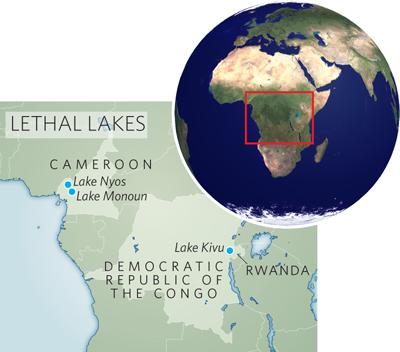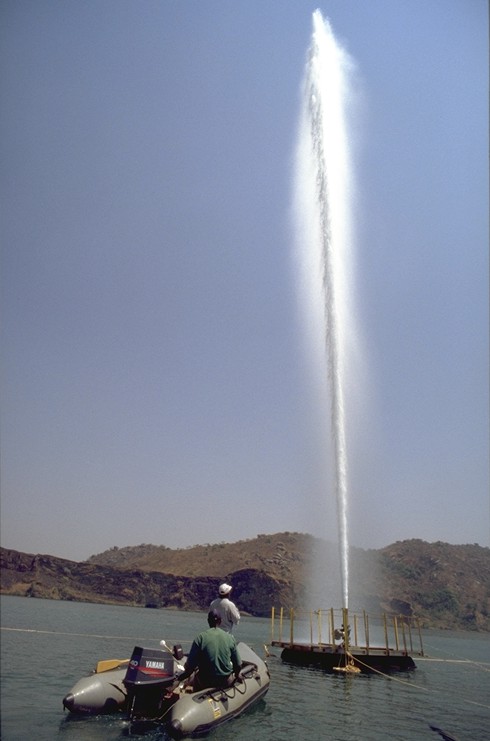It looks like you're using an Ad Blocker.
Please white-list or disable AboveTopSecret.com in your ad-blocking tool.
Thank you.
Some features of ATS will be disabled while you continue to use an ad-blocker.
22
share:
I haven’t been able to find a thread regarding this topic so I thought I would share this with all of you.
I recently watched a doc called Killer Lakes.
First of all, a limnic eruption is an event where large amounts of CO2 are released through volcanic activity or decay of plant matter directly beneath these lakes. The lake eventually becomes saturated with CO2 which is then released violently in a limnic eruption. A trigger event is all that is needed to cause an eruption. For instance: the 1986 eruption was believed to have been caused by landslides. Other triggers can include volcanic eruptions, earthquakes and even rain storms.

And then there is Lake Kivu, which sits on the border between the Democratic Republic of the Congo and Rwanda. Kivu has very high concentrations of methane as well as CO2.
Lake Kivu is approximately 2,000 times larger than Nyos and has about 2 million people living on it’s shores. It is situated very near an active volcano. Mount Nyiragongo which erupted as recently as 2002.
Source
Venting Lake Nyos

Turn a negative into a positive?
Now Lake Kivu is estimated to have at least 55 billion cubic centimeters of methane which regenerates at the rate of about 120 million cubic meters every year. The government of Rwanda is working to exploit this natural resource while possibly preventing another limnic eruption on the scale of the one that occurred in the early Eocene.
Currently there are two ongoing methane-to-electricity projects and one potential project
Lake Kivu Methane Gas
I recently watched a doc called Killer Lakes.
First of all, a limnic eruption is an event where large amounts of CO2 are released through volcanic activity or decay of plant matter directly beneath these lakes. The lake eventually becomes saturated with CO2 which is then released violently in a limnic eruption. A trigger event is all that is needed to cause an eruption. For instance: the 1986 eruption was believed to have been caused by landslides. Other triggers can include volcanic eruptions, earthquakes and even rain storms.
Lake Monoun in 1984, causing the asphyxiation and death of 37 people living To date, this phenomenon has been observed only twice. The first was in Cameroon at nearby. A second, deadlier eruption happened at neighbouring Lake Nyos in 1986, this time releasing over 80 million cubic meters of CO2 and killing between 1,700 and 1,800 people, again by asphyxiation.

And then there is Lake Kivu, which sits on the border between the Democratic Republic of the Congo and Rwanda. Kivu has very high concentrations of methane as well as CO2.
Lake Kivu is approximately 2,000 times larger than Nyos and has about 2 million people living on it’s shores. It is situated very near an active volcano. Mount Nyiragongo which erupted as recently as 2002.
Sample sediments from the lake were taken by Professor Robert Hecky from the University of Michigan which showed that an event caused living creatures in the lake to go extinct approximately every thousand years, and caused nearby vegetation to be swept back into the lake.
Efforts have been under way for several years to develop a solution to remove the gas from these lakes and prevent a build-up that could lead to another catastrophe. A team of French scientists began experimenting at Lake Monoun and Lake Nyos in 1990 using siphons to degas the waters of these lakes in a controlled manner. A pipe is positioned vertically in the lake with its upper end above the water's surface. Water saturated with CO2 enters the bottom of the pipe and rises to the top. The lower pressure at the surface allows the gas to come out of solution
Source
Venting Lake Nyos

Turn a negative into a positive?
Now Lake Kivu is estimated to have at least 55 billion cubic centimeters of methane which regenerates at the rate of about 120 million cubic meters every year. The government of Rwanda is working to exploit this natural resource while possibly preventing another limnic eruption on the scale of the one that occurred in the early Eocene.
Currently there are two ongoing methane-to-electricity projects and one potential project
1. Contour Global (CG) US-based Company, through its subsidiary KivuWatt Ltd, is interested in converting Lake Kivu Methane gas energy potential into electrical power generation of 100 MW in two phases. Ideally, the first phase is targeting to deliver to the national grid the electrical power of 25 MW by end 2012 and followed by 75 MW for the second phase.
1. The Rwanda Energy Company (REC) is a subsidiary of Rwanda Investment Group (RIG). This company has been granted a gas concession agreement to develop a gas fired power plant in Rwanda. This pilot project has the objective of producing 3.6 MW in the first phase before moving to the production 50 MW memorandum of Agreement (MoA) with GoR.
1. In March 2005, the first Gas Concession Agreement (GCA) for the extraction of methane gas tapped in deep water of Lake Kivu for power generation was awarded by GoR to the Kibuye Power 1 (KP1) project, with the overall mandate to exhibit the possibility of electricity production from the methane gas. The facility is currently generating almost 2 MW of electricity, half of its installed capacity of 4 MW because of technology bottlenecks.
Lake Kivu Methane Gas
edit on 26-8-2012 by Neysa because:
(no reason given)
edit on 26-8-2012 by Neysa because: I linked to the WRONG Documentary. It has been corrected.
edit
on 26-8-2012 by Neysa because: (no reason given)
I embedded the wrong documentary in my OP.
It has been changed to the correct one.
Sorry for the mix up.
It has been changed to the correct one.
Sorry for the mix up.
reply to post by Neysa
Hey, this could be awesome if the citizens of that nation do not get ripped off in the process, as I've noticed often happens when a poor nation has natural resources. Free electricity for everybody in the world!! Or at least for those who cannot afford it. I think Rwanda falls under that category, or most Rwandans. I wonder what progress has been made in the past year. I'll be surprised if they don't put an extension on that siphon pipe to lead it straight to the nearest 1st world nation...the cost of that pipe may exceed the value of the methane, but as long the people do not benefit from it that's all they care about.
Hey, this could be awesome if the citizens of that nation do not get ripped off in the process, as I've noticed often happens when a poor nation has natural resources. Free electricity for everybody in the world!! Or at least for those who cannot afford it. I think Rwanda falls under that category, or most Rwandans. I wonder what progress has been made in the past year. I'll be surprised if they don't put an extension on that siphon pipe to lead it straight to the nearest 1st world nation...the cost of that pipe may exceed the value of the methane, but as long the people do not benefit from it that's all they care about.
new topics
-
Trump-appointed judge blocks Biden administration overtime rule
Social Issues and Civil Unrest: 8 minutes ago -
Don't cry do Cryo instead
General Chit Chat: 5 hours ago -
Tariffs all around, Except for ...
Dreams & Predictions: 7 hours ago
22
